Recent Posts
-
Real Crimes and the Coming Violence
September 6, 2025
-
Whither Modern Life?
June 27, 2025
-
What the Hell
June 18, 2025
-
As Darkness Engulfs Us
April 6, 2025
-
AI, Risk, and Work
January 17, 2025
-
“Things Are in the Saddle, and Ride Mankind”
December 29, 2024
-
Forgotten Futures in Seattle
December 12, 2024
-
Autocracy Defeats Neoliberalism
November 14, 2024
-
History… We’re Soaking in It!
October 2, 2024
-
A Numbing Spectacle
September 22, 2024
|
 Mais amor, or “more love” was the recurrent theme running through the 3rd World Bike Forum in Curitiba, Brazil. After almost a week of travel and visiting Porto Alegre and Sao Paulo, it was time to fulfill my primary reason for travelling to Brazil this time. I took the plane to Curitiba in Paraná state, south of Sao Paulo, and was met at the airport by Danilo, a bicycle transportation coordinator for the City, but also a major activist and participant in organizing the Forum Mundial da Bicicleta III (3rd World Bike Forum) here. He was just the first of many wonderful people I met in Curitiba, characterized by warmth, generosity, enthusiasm, and huge hearts!
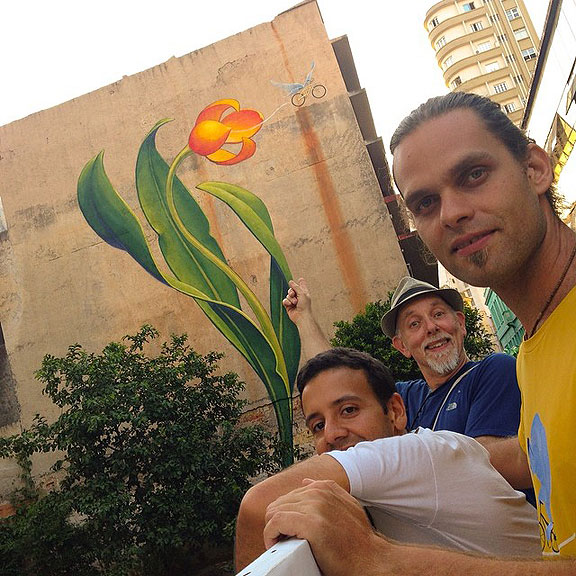 Goura and Luis Patricio were stalwarts on a team of wonderful people who made the Forum a great success. Me? I just hung around pointing at things I like! 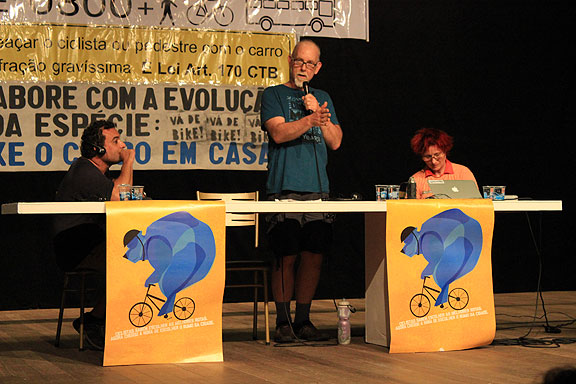 Here I am giving my Talk on Friday night before the wet Critical Mass on Feb. 14 in Curitiba. I was an invited guest to the first Forum two years ago in Porto Alegre, so it was an unexpected pleasure and honor to be invited again so soon. I had always wanted to see Curitiba, a city famous for being an early innovator in Bus Rapid Transit and garbage recycling programs a couple of decades ago. Today it is probably the calmest city I’ve been to in Brazil, fairly prosperous, and full of long pedestrian areas and a few wonderful bikeways that run many kilometers from the center to the outer edges of the city. The one I took every day runs just a half block from the home of Cassinha and Joaquim, my amazing and super generous hosts. Cassinha was also a key player on the organizing committee for the Forum, helping get a big donation from the local Industrial Association among her many talented contributions.
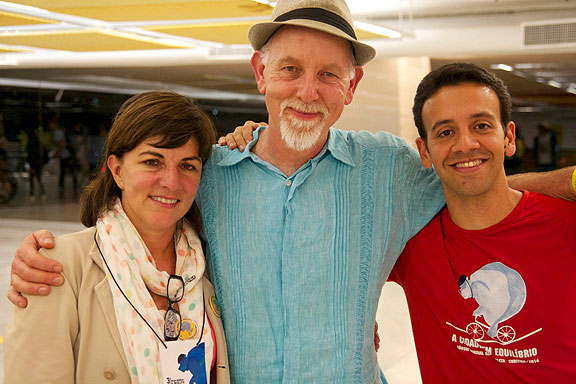 Cassinha on one side, Luis Patricio on the other, at the World Bike Forum. I have to admit I was feeling a bit jaded before the Forum began, having been to the first one two years ago, and before that to two different “Towards Car-Free Cities” conferences (Portland in 2008 and Guadalajara in 2009) and also a “Congreso Nacional de Ciclismo Urbano” conference in Guadalajara too. Similar experiences were had too in various international gatherings (albeit not about bicycling per se) in the World Social Forum in Belém, Brazil, and the Copenhagen Climate Change conference in 2009. But after four days of meeting, attending various presentations, riding in a “Bicicletada” (Critical Mass) in the rain on Valentine’s Day (actually in Brazil Valentine’s Day is June 12, same day celebrated as Mother’s Day in Mexico I think), getting a side trip in to visit Nova Primaveira (a squatted quasi-nowtopian community in the shadow of a big modern Toshiba Factory in the City of Industry section of Curitiba) and topping it off with a day-long journey to ride down the famous “Serra da Graciosa” yesterday, I have had a fantastic time here. So many wonderful people converge on these gatherings, mostly Brazilians from all over the country, but this time we also had Elly Blue from Portland, Carlos Marroquin from Bicimaquinas in Guatemala, Mona Caron (and Dustin Fosnot) from San Francisco, Carlos Cadena Gaitán from Medellin (via Maastricht, Holland), Lars Gemzøe from Copenhagen, Uwe Redecker from Kiel Germany, Olga Sarmiento from Bogotá, Galo Cardenas from Quito, Charlotte Fagan from Boston’s Bikes Not Bombs, and so on. I tend to think of this as a “Brazil Bike Forum” with international guests, akin to the annual Ciclismo Urbano conferences in Mexico (especially when you consider that the opening night’s session featured 6 guest speakers, all Brazilian, all in Portuguese without translation).
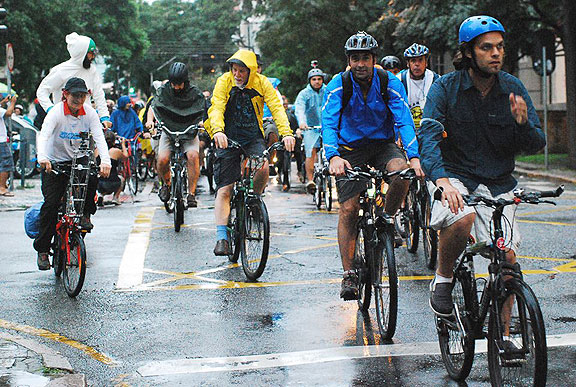 A soggy Critical Mass in Curitiba, here I am in conversation with Brazilian bike activist pioneer Renata Falzoni; Danilo and Goura in front. Continue reading Mais Amor: Forum Mundial da Bicicleta III in Curitiba, Brazil
 I gave my Nowtopia talk in front of Cafe Bonobo in Porto Alegre, Brazil, on Sunday, February 9. 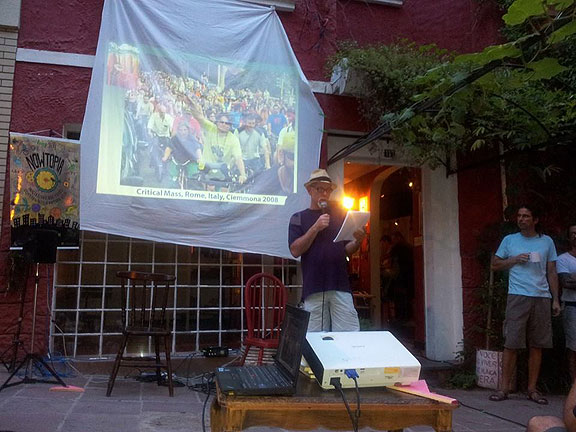 I decided I should read the excerpts from Nowtopia in the new Portuguese translation… wasn’t easy, but I’m pretty sure I was at least understandable, though no doubt I mangled a lot of words as well as the proper rhythm/emphasis. 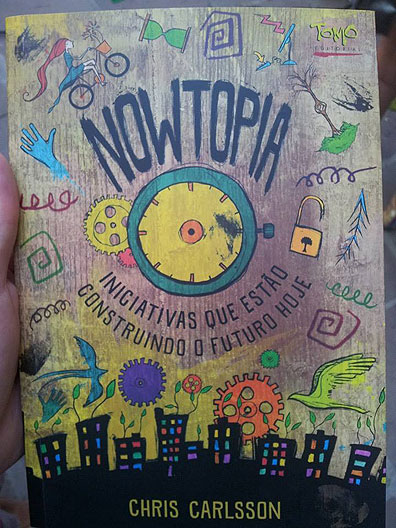 The Brazilian edition! Just wrapping up a fantastic 12 days in Brazil which started with flight delays and lost luggage as I arrived in Sao Paulo, only to rush on to Porto Alegre with borrowed clothes for the release of the Brazilian edition of Nowtopia. The publisher, Tomo Editorial of Porto Alegre, who I didn’t really know much about before arriving, turned out to be a very well organized, intelligent, respected small publishing house there, and I am very happy and proud to be associated with them. João Carneiros and Nazareth and Krishna and the rest of the staff were wonderful, and did a great job on book production and setting up a couple of events for me to launch the book and handling sales. And we had very good results: over 200 books sold in a little over a week of its availability!
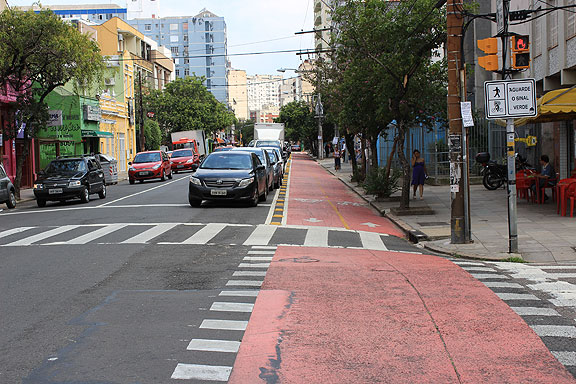 I was in Porto Alegre for the 1st World Bike Forum in 2011, which was held on the 1st anniversary of a mad businessman driving through Critical Mass at full speed along this street. There is now a dedicated, separated cycletrack on this same street. Looks like progress to me! My friends at Café Bonobo hosted me and the presentation in Porto Alegre, and I had a great time trying to read the translated version of Nowtopia excerpts in Portuguese. Apparently I didn’t mangle it completely because many people told me they were very happy with my effort, even if I knew I did a pretty terrible job on pronunciation and emphasis. I was asked during the question-and-answer period about my attitude towards veganism and I suppose that left a bad taste in a lot of mouths in Porto Alegre. There are a lot of vegans among the cycling crowd there who were the natural constituency for Nowtopia, but some at least are disgusted by my alleged “hypocrisy” for not being vegan. I explained that I was a liberal on this question—people are of course free to choose what they want to do in terms of eating and ethics. But that was not an adequate answer for the neo-Calvinist vegans in the crowd, for whom their choice is the only ethical choice. I tried to explain how some of my friends who were once vegan had stopped for health reasons (in some cases) and the last person to ask me a question instead launched into a diatribe about how those friends of mine were “not failed by veganism! They failed veganism!!” Wow! Between that, and a facebook commentator by the name of Waldimir Evangelista Vegano, I don’t think there’s any response at all. They have strongly reinforced my first comment, which was that too many vegans are somewhat authoritarian about their attitudes, which seems to be rooted in a puritanical neo-Christian moralism. Not all vegans are like that, and my hosts are lovely people who do not impose their principled veganism on those around them, by contrast. In any case, I love Porto Alegre and look forward to more visits in the future.
Continue reading Nowtopia in Brazil
(Published also today at shareable.net)
I started reading Adam Greenfield’s new book, Against the Smart City, with the expectation that it would be a critical view of the ways our urban lives have changed during the past half decade with the massive adoption of so-called “smart phones” and the rest of the ubiquitous technosphere. But it turns out he has a rather different target in mind. His polemic, delivered by EPUB and kindle only (so far), is directed at a techno-utopian fantasy promulgated by large multinational corporations and their government client-sponsors.
Specifically, he spends most of his book going point-by-point over the absurd claims of efforts to build cities in “empty” spaces; that is, brand new urban complexes built from scratch in reclaimed mudflats in the sea, or in one case in an “undeveloped” rural valley in Portugal. The three targets of Greenfield’s scathing critique are the Korean New Songdo, Masdar City in the United Arab Emirates, and a planned small city in Portugal called PlanIT Valley. “These are putatively urban-scale environments designed from the ground up with information-processing capabilities embedded in the objects, surfaces, spaces and interactions that between them comprise everyday life. They are held up before us as forerunners and exemplars of the kind of urban environment we might inhabit once the cities of Earth have been decisively colonized by networked informatics, at some point in the undefined but not-too-distant future.”
 Pictured above: A rendering of Masdar City, a “smart city” in the United Arab Emirates. By Forgemind ArchiMedia under a Creative Commons license from Flickr.com. The three big corporations at the heart of this below-the-radar industrial fantasy are IBM, Cisco Systems, and Siemens AG (of Munich, Germany). These companies are very familiar with large-scale projects and like to imagine they are capable of re-engineering life itself (IBM’s hubris-filled slogan these days is “let’s make a smarter planet”). They have all brought software- and hardware-linked systems to the market, offering urban planners a turnkey “solution” for everything that faces a generic municipal government. As Greenfield ably shows, the rhetoric, vision, and reality of these corporate schemes depends on an alarming amnesia and disregard for both history and actual knowledge about how cities really function.
While trading in the grand claims of cyberspace and seamless integration and frictionless futures, the urban life these corporations are trying to manage actually depends on real people moving through real environments, using everything from their feet to bicycles to cars and trains. Their sales pitch depends on a flattening of layered realities and omitting complex knowledge from more than a century of urban planning, history, and analysis:
Of the major technology vendors working in the field, Siemens makes the strongest and most explicit statement of the philosophical underpinnings on which their (and indeed the entire) smart-city enterprise is founded: “Several decades from now cities will have countless autonomous, intelligently functioning IT systems that will have perfect knowledge of users’ habits and energy consumption, and provide optimum service…The goal of such a city is to optimally regulate and control resources by means of autonomous IT systems.”
We act in historical space and time, as do the technological systems we devise and enlist as our surrogates and extensions. So when Siemens talks about a city’s autonomous systems acting on “perfect knowledge” of residents’ habits and behaviors, what they are suggesting in the first place is that everything those residents ever do — whether in public or in spaces and settings formerly thought of as private — can be sensed accurately, raised to the network without loss, and submitted to the consideration of some system capable of interpreting it appropriately. And furthermore, that all of these efforts can somehow, by means unspecified, avoid being skewed by the entropy, error and contingency that mark everything else that transpires inside history.
Soon after plunging into Against the Smart City I began to wonder why so much analytical effort had been spent debunking what seem to me to be patently absurd assertions by corporate PR departments. While I appreciate Greenfield’s detailed rebuttals to the Smart City propagandists, I found myself bogging down. I can’t really believe these plans are being built or will ever come anywhere near to their claims. Greenfield’s critique leaves little room for anyone to suggest that these “smart city” plans are anything but self-evidently ridiculous.
For all of the conceptual flaws we’ve identified in the Siemens proposition, though, it’s the word “goal” that just leaps off the page. In all my thinking about cities, it has frankly never occurred to me to assert that cities have goals. (What is Cleveland’s goal? Karachi’s?)…By failing to account for the situation of technological devices inside historical space and time, the diversity and complexity of the urban ecology, the reality of politics or, most puzzlingly of all, the “normal accidents” all complex systems are subject to, Siemens’ vision of cities perfectly regulated by autonomous smart systems thoroughly disqualifies itself. But it’s in this depiction of a city as an entity with unitary goals that it comes closest to self-parody.
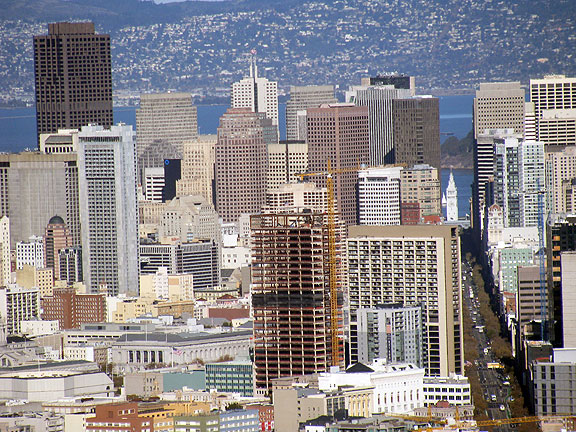 The frenzy of construction and upward growth continues unabated in San Francisco while we all await the next, inevitable crash. As I read along I kept feeling like I’d seen all this before. And finally, about 75% into the book, Greenfield confirmed my suspicions. In his chapter on “overspecification” he points out the brittleness of their vision, the bizarre lack of flexibility, the sheer hubris of their overdetermined plans. For the Portuguese PlanIT Valley the designer
Appear[s] to allocate commercial, residential and retail sectors around a central public space, in a radial scheme as inelastic as Disneyland’s…The city’s functions are dispersed among discrete Retail, Residential, Research and Entertainment quarters, there to remain…the strict functional segregation of activity into designated, single-purpose districts is a hallmark of high-modernist urban planning, finding its earliest pure expression in Le Corbusier’s unbuilt Plan Voisin of 1924 and reaching an apotheosis in post-war plans like those for Brasília and Chandigarh.
Continue reading Agin the Smaht Cit-ay!
|
Hidden San Francisco 2nd EDITION!

NEW 2nd EDITION NOW AVAILABLE!
Buy one here
(Pluto Press, Spring 2025)
|






















